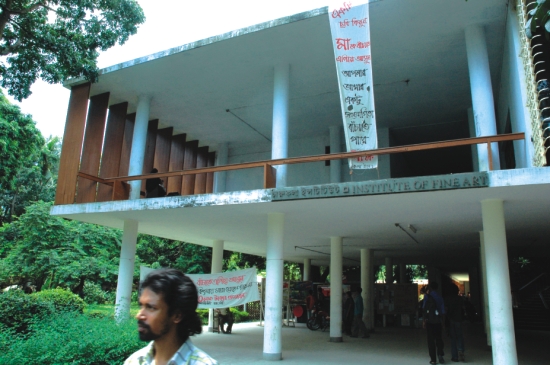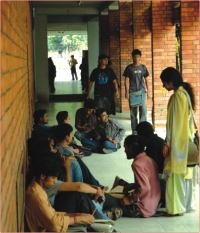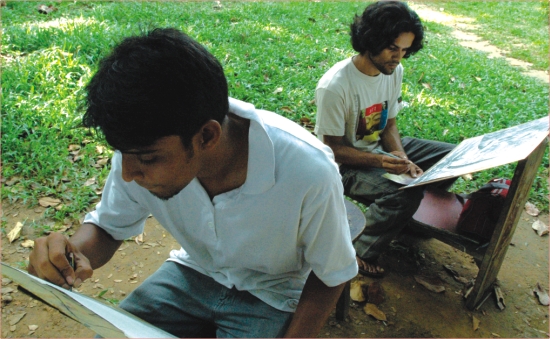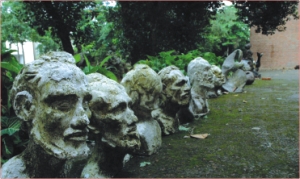Charukala
Fusion of tradition and modernism

Ferdous Khan
Institute of Fine Arts started its artistic journey in the year of 1948. Its name was Government Institute of Art at that time. Zainul Abedin, the talisman of Bangladesh, who was a teacher in the Calcutta Art College, he moved to Dhaka when the partition of Bengal took place in 1947
 Subsequently, he lobbied with the education authorities for the cause of an art school in the newly born capital city Dhaka. He was in collaboration with Quamrul Hasan, Anwarul Haque, Safiuddin Ahmed, Habibur Rahman and Sayed ALi Ahsan. Despite the opposition of the orthodox people, their collective efforts were soon crowned with success.
Subsequently, he lobbied with the education authorities for the cause of an art school in the newly born capital city Dhaka. He was in collaboration with Quamrul Hasan, Anwarul Haque, Safiuddin Ahmed, Habibur Rahman and Sayed ALi Ahsan. Despite the opposition of the orthodox people, their collective efforts were soon crowned with success.
The institute was set up with Zainul Abedin as its principal and classes began in November 1948. When the class began Artist Anwarul Haque served as an acting principal. Because Zainul took his new responsibility, as the chief designer of Information and Broadcasting Department of Pakistan Central Government. In March 1949, he took his post as principal of the institute. Some notable students of the first batch were Aminul Islam, Hamidur Rahman, Abdur Rahman Bhuiya, Abdul Kader, Mohammad Ismail and Alfaz Uddin among others.
Some noteworthy students of 2nd batch were Murtaja Baseer, Rasheed Chwodhury, Qayyum Chowdhury, Abdur Razzaque and Emdad Hossain. The institute was then housed in a couple of rooms in the National Medical College at Johnson Road. In that period progressive people, journalists and cultural personalities played pivotal role to set up a complete fine arts school in the country.
Even they took some initiatives. Among them some mentionable persons were scientist Dr Mohammad Kudrat-E-Khuda, Salimullah Fahmi and the deputy secretary of health department Dr Mohammad Abul Kashem. Besides, Dr Mohammad Enamul Haque and Dr Mohammad Habibullah contributed in this aspect. Zainul and his colleagues began lobbying with the government for seperate premises for the institute. Eventually, a two-storied house at Segunbagicha was allotted for the institute.

The teachers' work was to promote art and art education. . They proposed to the government to sanction the construction of a newly-designed building for the art institute on a vast plot of land in Shahbag. Architect Mazharlul Islam designed it and finished the construction work in 1956. It was all set to begin. Meanwhile, the institute started taking the female students in 1954.
The institute started off with 3 departments -- Drawing and painting that was named Fine Arts Department, Commercial Department (graphics design) and Printmaking Department to promote art. Subsequently, Oriental Art Department was launched in 1955, Ceramic in 1962, Sculpture in 1962 and Craft in 1972.
The institute turned into a first-grade government college in 1963. It was named East Pakistan Arts and Craft College.
After the post-liberation period, it was renamed Bangladesh Art and Craft College. The  department introduced MFA course since 1978. In 1983 it was incorporated as an institute of Dhaka University. The honours course replaced the old curricula in the academic session of 1992-93.
department introduced MFA course since 1978. In 1983 it was incorporated as an institute of Dhaka University. The honours course replaced the old curricula in the academic session of 1992-93.
The BFA honours course spans four years and the MFA course for another two years. A student has to study six consecutive years, as detailed in the syllabus to achieve MFA degree. At present, there are eight departments in the institute -- Drawing and Painting, Graphic Design,
Printmaking, Sculpture, Oriental Art, Ceramics, Crafts and History of Art. A total of 2200 marks are used in BFA course to assess the performance of a student. The course entails 1700 marks in practical part and 500 in the theory. A total of 1000 marks are allotted for MFA course. The students who pass their HSC successfully and get at least 45 per cent marks can apply here. Candidates have to face tough competition to get admission in the institute. An applicant will have to go through written, drawing and design examination, which contains 200 marks.
During the early years of art education few students got themselves admitted in the institute. Afterward the artists, art critics, writers and journalists helped to enhance the demand of fine arts. In view of increasing demands many students are taking part in the admission test nowadays.
The necessity of fine arts is thriving day by day to construct a splendid society. Despite asymmetry in status and economic power, the job opportunity for the artists increased successfully. By the process of industralisation, urbanisation and economic boom, the necessity of art and artists are important components for an effective society. Painting, sculpture and all sphere of arts help understand the tradition of culture and help to progress in the international arena.
In the post independent era, art education was rearranged with vigorous force and motto of education, business, society and culture.
education, business, society and culture.
After the70s, the fine arts movement was centred not only in Dhaka. Art academies were also established in Chittagong, Khulna and Rajshahi, and the artists from these academies are earning laurels home and abroad.
In the first year students obtain primary knowledge about all the courses in fine arts. After completing first year, they get entry into the respective departments.
In this phase they participate in the combined theory class. Following are the details of the departments.
Drawing and Painting Department:
Initially its name was Fine Arts Department, but it assumed its present name in 1963. In this department students follow the genre of European Academy, blending a variety of colours. Artist Shafiqul Amin, Zainul Abedin and Habibur Rahman used to take classes in this department. Besides, some former and incumbent teachers of the institute were also students of this department.
In this context the names of Abdur Razzaque, Qayyum Chowdhury, Shamsul Islam Nizami, Hashem Khan, Abdus Shakoor, Abul Bark Alvi, Mahmudul Haque and Hamiduzzaman Khan are remarkable. The department led the students to create a form with enthusiastic light and shade, or to make a flawless journey through sketch or painting with human figure, animals and landscapes. Different media such as pen, pencil, brush, water colour, acrylic and oil colours are used to depict a complete drawing or sketch.
The necessity of this department is boundless, because the students will engage themselves in practicing newer idioms through their individual effort after passing out from the department. If someone enters the institute, s/he will notice a vast veranda. Basically, the department starts from this point. Seven rooms in the ground floor and first floor are used as classrooms. At present, Professor Matlub Ali serves as the head of the department. Other teachers of the department are Rafiqun Nabi, Dr Fardida Zaman, Jamal Ahmed, Nisar Hossain, Shishir Batthacharjee, Sheikh Afzal and Mustafizul Haque. Around 192 students are presently studying in the department.
Graphic Design Department:
Eminent artist Quamrul Hasan was the founding head of this department. At present, associate professor Mamun Kaiser is working as the head. Other teachers who reinforce quality education with their enthusiasm are Naima Haque, Mohammad Younus, Maqsudur Rahman, Reza-Al-Hoda Anupom and Israfil Raton. The students are trying to flourish the quality of the design with the help of sophisticated technology including computer and photographs. After completing the MFA degree, students work for different advertisement firms as graphic designer or art director. The artists from this department implement various companies' product design that persuades the consumers to buy their product.
 Different tools such as water colour, poster colour, oil colour, pencil and pen are used to create the drawing, sketch, still life, poster, logo, book cover, illustration, advertisement etc. graphic department borders with a queer green belt. A total of 140 students are studying in the department.
Different tools such as water colour, poster colour, oil colour, pencil and pen are used to create the drawing, sketch, still life, poster, logo, book cover, illustration, advertisement etc. graphic department borders with a queer green belt. A total of 140 students are studying in the department.
Printmaking Department:
Eminent artist Safiuddin Ahmed founded this department. Artist Habibur Rahman also joined as a wood-engraving teacher and Sheikh Anwar was enlisted as a pressman in 1948. At present, the number of students reached nearly 60. Two lithograph machines and two etching machines are now in use. Its own building has six rooms. Students do their work with three different media such as woodcut, etching and lithograph. Artist Rokeya Sultana is serving as the head of the department. Four teachers are involved with the department.
Oriental Art:
At the beginning of the department of Oriental Arts in 1955, Shafiqul Amin took responsibility as the head of the department. Eminent Artist Rasheed Chowdhury, back from France, served as the head of the department for just a year. In 1969, painter Hashem Khan joined the department. Since then a new dimension was added to the department.
Proto-modernist Aminul Islam joined in 1968 and taught successfully up to 1983. It is known to us that the necessity of oriental style was against the aggression of western art.
Oriental art, especially the indigenous heritage of Bengal was waning day by day.
The students got acquainted with the new realm of the traditional art of India, China and Bangladesh. Three teachers are working relentlessly to bring out the expected expansion of the department.
Sculpture:
In this department the prime objective is to construct a three-dimensional form or surface that can even be perceived by touch.
that can even be perceived by touch.
The Sculpture Department was set up in 1963. Late artist Abdur Razzaque, who got his MFA from Iowa State University in USA, set up the sculpture department. The department shifted to its own building in 1981. At present, five teachers are teaching in this department with Enamul Haque as the chair. Sculpture allows us with the hands-on experience. A three-dimensional object also called 'Plastic Art' can communicate more than two-dimensional ones.
Crafts:
In the syllabus the teaching method is divided in two criteria--applied art and commercial art. Tapestry, woodwork, screen print, print and sketch are done in this department. There are three teachers in the department.
History of Art:
The history of the art department is an eminent part of the institute. According to the demand of modern art, the artist is not a craftsman; he reveals the true aesthetic and intellect in himself. The department's aim is to provide the students with concrete knowledge and deep understanding about the evolution of art, aesthetic of art, politics, economics and religion. Though the institute was established in 1948, the inclusion of history in the programme was only from 1963. After the liberation the department introduced Bangla literature. At present, three teachers are teaching in the department.
The library is well equipped and rich in collection. Here someone can find a huge assortment of art-related books. The students of master's course implemented their expertise with the help of the library. At present, there are over 8371 books and 359 theses in the library.
Professor Abdus Shakoor is now the director of the institute. There are two galleries in the institute for showcasing the hand-painted pictures in the institute.

Zainul Abedin, reverently called the Shilpacharya, was the pioneer of the modern art movement in Bangladesh that began with the setting up of the Institute of Fine Arts. He is considered the mascot for spearheading art movement in the country. Today the institute has been in existence for 50 years and still upholds the heritage of Bangladesh.
Copyright
(R) thedailystar.net 2006
